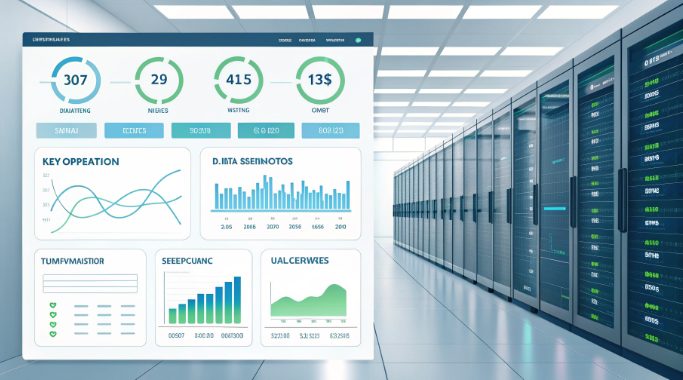Key Indicators for Stable Operation of US Data Center

In the ever-evolving landscape of digital infrastructure, understanding server stability metrics in US data centers has become crucial for both server hosting and colocation services. This comprehensive guide delves into the technical intricacies of server performance indicators, essential for maintaining optimal operational efficiency in American data centers.
Network Connectivity Metrics: The Foundation of Server Performance
Network connectivity forms the backbone of server operations, with latency being a primary indicator of performance. In US data centers, latency measurements typically range from 0.3ms to 50ms, depending on geographical distribution. Network engineers should monitor these metrics using specialized tools like MTR (My TracerRoute) or specialized network monitoring solutions.
Understanding Packet Loss and Its Impact
Packet loss, measured as a percentage of data packets that fail to reach their destination, directly affects server responsiveness. Industry standards consider packet loss rates below 0.1% as acceptable for most applications. However, for high-frequency trading or real-time applications, even 0.01% packet loss can be significant.
Bandwidth Stability Analysis
Modern US data centers typically offer bandwidth capabilities ranging from 1Gbps to 100Gbps. Key considerations include:
- Sustained vs. Burst Bandwidth Rates
- 95th Percentile Billing Methods
- Quality of Service (QoS) Implementation
Hardware Performance Metrics: Beyond Basic Monitoring
Advanced hardware monitoring requires sophisticated telemetry analysis. Enterprise-grade servers in US data centers typically implement the following monitoring thresholds:
- CPU utilization: Alert threshold at 85%
- Memory usage: Warning at 80%, critical at 90%
- Storage I/O: IOPS monitoring with baseline profiling
CPU Performance Analysis and Thermal Management
CPU performance optimization involves more than just monitoring utilization. Key metrics include:
- Thread usage distribution
- Context switching rates (optimal: <5000/second)
- CPU temperature delta (ΔT should not exceed 20°C under load)
Modern data centers implement advanced cooling solutions, maintaining ambient temperatures between 18-27°C (64.4-80.6°F) as per ASHRAE guidelines.
Memory Usage Patterns and Optimization
Memory management extends beyond simple RAM utilization metrics. Critical factors include:
- Page fault frequency (normal range: <1000/second)
- Swap usage patterns (should not exceed 20% of total RAM)
- Memory fragmentation index (optimal: <10%)
Implementation of proper memory monitoring tools like vmstat and free requires understanding of system-specific memory architectures.
Storage Performance Metrics
Storage performance in US data centers is measured through multiple vectors:
- Sequential Read/Write: Minimum 500MB/s for SSDs
- Random Read/Write IOPS: 10,000+ for enterprise SSDs
- Latency: <1ms for local storage, <10ms for networked storage
Enterprise storage solutions should implement S.M.A.R.T. monitoring with predictive failure analysis.
System Reliability and Uptime Metrics
Reliability engineering in US data centers focuses on quantifiable metrics:
- Mean Time Between Failures (MTBF): Target >50,000 hours
- Mean Time To Recovery (MTTR): Target <15 minutes
- Availability: Minimum 99.95% (4.38 hours downtime/year)
These metrics form the foundation of Service Level Agreements (SLAs) and operational excellence frameworks.
Load Balancing and System Distribution
Load distribution algorithms implement sophisticated balancing techniques:
Load_Factor = (Active_Connections * 100) / Max_Connections
Warning_Threshold = 75%
Critical_Threshold = 90%
Modern load balancers utilize dynamic weights and health checks with sub-second intervals.
Security Metrics and DDoS Protection
Security infrastructure in US data centers implements multi-layered protection:
- Traffic anomaly detection (baseline deviation >30%)
- Packet filtering rates (capable of handling 100Gbps+ attacks)
- Connection tracking table size (minimum 1M concurrent connections)
Advanced DDoS mitigation systems should respond within 10 seconds of attack detection.
Backup and Recovery Metrics
Data protection strategies follow the 3-2-1 rule with specific performance indicators:
- Recovery Point Objective (RPO): <4 hours
- Recovery Time Objective (RTO): <2 hours
- Backup Success Rate: >99.9%
Implement verification procedures for all backup sets with SHA-256 checksums.
Monitoring System Architecture
Enterprise monitoring systems should implement hierarchical data collection:
Collection Interval Tiers: - Critical metrics: 10-second intervals - Performance metrics: 30-second intervals - Trend metrics: 5-minute intervals Data Retention Policy: - Real-time data: 24 hours - Hourly aggregates: 30 days - Daily aggregates: 1 year
Implement redundant monitoring with failover capabilities to ensure continuous visibility.
Practical Implementation Guidelines
When deploying servers in US data centers, consider these technical specifications:
- Network card buffer size: minimum 2MB per port
- TCP window size: 64KB-1MB depending on latency
- System time sync: NTP stratum-2 or better
Configure monitoring thresholds based on application-specific requirements rather than generic values.
Frequently Asked Questions (FAQ)
Q: What’s the optimal monitoring interval for production servers?
A: Implement variable monitoring intervals: 30 seconds for critical services, 5 minutes for standard metrics, and 15 minutes for trend analysis.
Q: How to handle false positive alerts?
A: Implement alert correlation rules with minimum 2-3 confirmation cycles before escalation. Use adaptive thresholds based on historical patterns.
Conclusion
Maintaining optimal server performance in US data centers requires a comprehensive understanding of these technical metrics and continuous monitoring. For both hosting and colocation services, implementing these performance indicators ensures reliable operation and helps prevent system failures. Regular audit of these metrics, combined with proactive maintenance, forms the foundation of robust server infrastructure.

